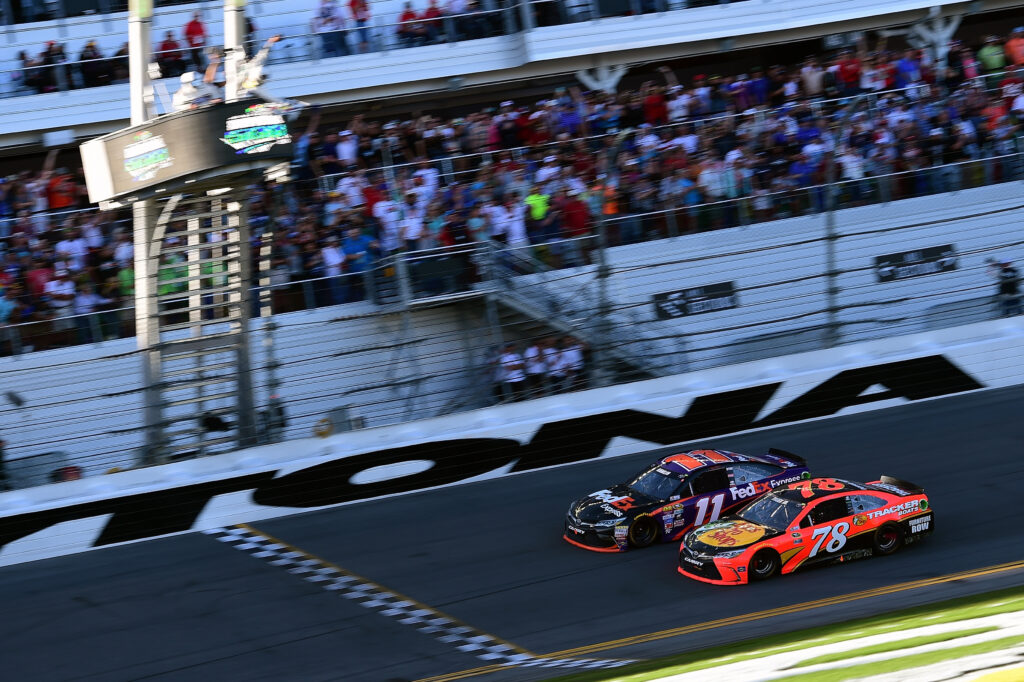Close Finishes, New Stars And Social Media Drive Increased Viewership of NASCAR Broadcasts

An emerging storyline that NASCAR could not have imagined in the early 2000s was about to reach a crescendo at the start of its 2016 season.
NASCAR, a beacon for sport business success at the turn of the millennium, with top viewership, attendance and sponsorship numbers, hit a rough patch following the the 2008 economic recession. Even as the stock car racing sanctioning body pushed out new talent and created a new championship format, its viewership numbers were lower than they were in the mid-2000s. Yet, the sanctioning body has seen its viewership numbers begin to stabilize over the last five-years, averaging five million viewers per NASCAR Sprint Series Cup race. However, with viewership numbers down 18-percent after 2016’s first two NASCAR races, it seemed as though viewership of America’s Cinderella sport was taking a big hit early this season.
Those sentiments wouldn’t last long, though, because midway through the 2016 season, NASCAR has made an unprecedented turn around, with ratings down 3-percent and trending upward. Some even believe that the season can end with positive ratings.
So, what changed so quickly? And what’s the lesson for other sport entities on how to recapture and drive greater home viewership?
NASCAR’s road back to viewership success is paved with disseminating good, interesting and highly competitive racing. Looking back on the 2016 season thus far, fans were driven to televisions to witness two photo finishes at the Daytona 500 and at Phoenix. Arguably, NASCAR’s low viewership numbers at the start of 2016 could’ve been driven by new rules that it adopted. However, as the season moves forward it is likely those new rules that are helping produce the intense, side-by-side racing that’s leading fans to tune back in.

It’s one thing to say that highly competitive events draw viewership. It’s another for a league to be able to actually produce highly competitive events. Thus, also behind the growth of NASCAR’s 2016 viewership is the rise of fan interest in new talent. Sure, a large number of fans will be driven to watch this weekend’s race in Indianapolis, as Jeff Gordon prepares to come out of retirement to race for Dale Earnhardt Jr. However, through the start of the 2016 season, rookie Chase Elliott and 26-year-old Austin Dillon have quickly built admiring fan bases as their performances on the track have left both in contention to clinch spots in the Chase for the NASCAR Sprint Cup.
In a post-recession economy, NASCAR continues building strong brand partnerships that drive affinity in the sport. With 130 FORTUNE 500 companies currently investing in the sport across teams, tracks and the sanctioning body, the number of FORTUNE 500 companies investing in NASCAR since the 2008 economic recession has actually increased by 20-percent. Yet, NASCAR isn’t relying solely upon the increase in FORTUNE 500 partnerships to boost its viewership levels back to pre-recession levels. Rather, it has also turned to a significant digital strategy aimed at attracting millennials and more diverse fans to the sport.
Fan engagement has become central to NASCAR’s marketing strategy, and social media is the strategy’s launch pad. NASCAR is utilizing fan interest in its new and young stars alike to create social media content that drives television viewership and sport affinity. For instance, the Daytona 500 television broadcast featured custom hashtags which fans could utilize on Twitter for a chance to win race gear. According to NASCAR, the competition to win Dale Earnhardt Jr.’s firesuit generated 13,000 tweets in one-minute, a NASCAR record. Another successful social media campaign saw emerging star, Ryan Blaney, taking fans inside a recent trip to Costa Rica through NASCAR’s Snapchat account.
According to NASCAR, its new fan centric digital strategy is working, as engagement with NASCAR content across all platforms is up 83-percent, with more than 114 million total engagements. Video views on the NASCAR Facebook and Twitter accounts are up five-times over 2015, with fans viewing videos 76 million times this year alone.
While the sky was painted as falling for NASCAR at the start of the 2016 season, its executives have high hopes for the season’s final viewership outcome.
“If you haven’t caught a NASCAR race lately, you really haven’t seen some of the best racing we’ve had in years. Starting with photo finishes at the Daytona 500 and in Phoenix–and shattering records for green flag passing for the lead at several races along the way–we’re delighted here at the midpoint of our season that fans are tuning in and engaging across digital and social platforms like never before,” Brent Dewar, NASCAR’s chief operating officer told RULING SPORTS.
Get the free weekly newsletter so you can win the game.
